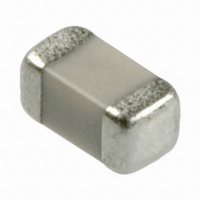06035C821KAT2A AVX Corporation, 06035C821KAT2A Datasheet

06035C821KAT2A
Specifications of 06035C821KAT2A
Related parts for 06035C821KAT2A
06035C821KAT2A Summary of contents
Page 1
... Frequency, MHz X7R formulations are called “temperature stable” ceramics and fall into EIA Class II materials. X7R is the most popular of these intermediate dielectric constant materials. Its tem- perature variation of capacitance is within ±15% from -55°C to +125°C. This capacitance change is non-linear. ...
Page 2
X7R Dielectric Specifications and Test Methods Parameter/Test Operating Temperature Range Capacitance Dissipation Factor Insulation Resistance Dielectric Strength Appearance Capacitance Resistance to Variation Flexure Dissipation Stresses Factor Insulation Resistance ≥ 95% of each terminal should be covered Solderability Appearance No defects, ...
Page 3
X7R Dielectric Capacitance Range PREFERRED SIZES ARE SHADED SIZE 0201 0402 Soldering Reflow Only Reflow Only Packaging All Paper All Paper MM 0.60 ± 0.03 1.00 ± 0.10 (L) Length (in.) (0.024 ± 0.001) (0.040 ± 0.004) MM 0.30 ± ...
Page 4
X7R Dielectric Capacitance Range PREFERRED SIZES ARE SHADED SIZE 1210 Soldering Reflow/Wave Packaging Paper/Embossed MM 3.20 ± 0.20 (L) Length (in.) (0.126 ± 0.008) MM 2.50 ± 0.20 (W) Width (in.) (0.098 ± 0.008) MM 0.50 ± 0.25 (t) Terminal ...
Page 5
... The solder temperature should not exceed 230°C. Chips 1808 and larger to use reflow soldering only. Capacitors with X7R Dielectrics are not intended for AC line filtering applications. Contact plant for recommendations. Capacitors may require protective surface coating to prevent external arcing ...
Page 6
High Voltage Chips For 500V to 5000V Applications C0G Dielectric PERFORMANCE CHARACTERISTICS Capacitance Range Capacitance Tolerances Dissipation Factor Operating Temperature Range Temperature Characteristic Voltage Ratings Insulation Resistance (+25°C, at 500 VDC) Insulation Resistance (+125°C, at 500 VDC) Dielectric Strength HIGH ...
Page 7
Packaging of Chip Components Automatic Insertion Packaging TAPE & REEL QUANTITIES All tape and reel specifications are in compliance with RS481. Paper or Embossed Carrier Embossed Only Paper Only Qty. per Reel/7" Reel 2,000, 3,000 or 4,000, 10,000, 15,000 Contact ...
Page 8
Embossed Carrier Configuration 8 & 12mm Tape Only DEFORMATION BETWEEN EMBOSSMENTS TOP COVER B TAPE FOR TAPE READER REFERENCE ONLY 1 INCLUDING DRAFT CONCENTRIC AROUND B 8 & ...
Page 9
Paper Carrier Configuration 8 & 12mm Tape Only T BOTTOM TOP COVER COVER TAPE TAPE & 12mm Paper Tape Metric Dimensions Will Govern CONSTANT DIMENSIONS Tape Size +0.10 8mm 1.50 1.75 ± ...
Page 10
Bulk Case Packaging BENEFITS • Easier handling • Smaller packaging volume (1/20 of T/R packaging) • Easier inventory control • Flexibility • Recyclable CASE DIMENSIONS Shutter Slider 12mm 36mm 110mm Attachment Base CASE QUANTITIES Part Size 0402 Qty. 80,000 (pcs ...
Page 11
... XII. Power Loss (watts) Power Loss = (2 π fCV 2 XIII. KVA (Kilowatts) KVA = 2 π fCV - XIV. Temperature Characteristic (ppm/°C) Ct – – 25 XV. Cap Drift (%) C – C. 100 C 1 XVI. Reliability of Ceramic Capacitors ( ) ( XVII. Capacitors in Series (current the same) Any Number --- Two ...
Page 12
... General Description Basic Construction – A multilayer ceramic (MLC) capaci- tor is a monolithic block of ceramic containing two sets of offset, interleaved planar electrodes that extend to two opposite surfaces of the ceramic dielectric. This simple Ceramic Layer Formulations – Multilayer ceramic capacitors are available in both Class 1 and Class 2 formulations. Temperature ...
Page 13
General Description Table 1: EIA and MIL Temperature Stable and General Application Codes EIA CODE Percent Capacity Change Over Temperature Range RS198 Temperature Range X7 -55°C to +125°C X5 -55°C to +85°C Y5 -30°C to +85°C Z5 +10°C to +85°C ...
Page 14
... A typical curve of aging rate for semi- stable ceramics is shown in Figure Class 2 ceramic capacitor that has been sitting on the shelf for a period of time, is heated above its curie point, (125°C for 4 hours or 150°C for 1 ⁄ ...
Page 15
... As a general statement, the piezoelectric output is higher, the higher the dielectric constant of the ceramic desirable to investigate this effect before using high “K” dielectrics as coupling capaci- tors in extremely low level applications. ...
Page 16
... Another important, often overlooked, reason for knowing the parasitic inductance is the calculation of the resonant frequency. This can be important for high frequency, by- pass capacitors, as the resonant point will give the most V signal attenuation. The resonant frequency is calculated from the simple equation: ...
Page 17
... Component Pad Design Component pads should be designed to achieve good solder filets and minimize component movement during reflow soldering. Pad designs are given below for the most common sizes of multilayer ceramic capacitors for both wave and reflow soldering. The basis of these designs is: WAVE SOLDERING D2 ...
Page 18
... Handling Chip multilayer ceramic capacitors should be handled with care to avoid damage or contamination from perspiration and skin oils. The use of tweezers or vacuum pick ups is strongly recommended for individual components. Bulk handling should ensure that abrasion and mechanical shock are minimized ...
Page 19
... AVX strongly recommends that any reworking of MLCs be done with hot air reflow rather than soldering irons practically impossi- ble to cause any thermal shock in ceramic capacitors when using hot air reflow. However direct contact by the soldering iron tip often caus- es thermal cracks that may fail at a later date ...
Page 20
... Surface Mounting Guide MLC Chip Capacitors Preferred Method - No Direct Part Contact PCB BOARD DESIGN To avoid many of the handling problems, AVX recommends that MLCs be located at least .2" away from nearest edge of board. However when this is not possible, AVX recommends that the panel be routed along the cut line, adjacent to where the MLC is located ...











